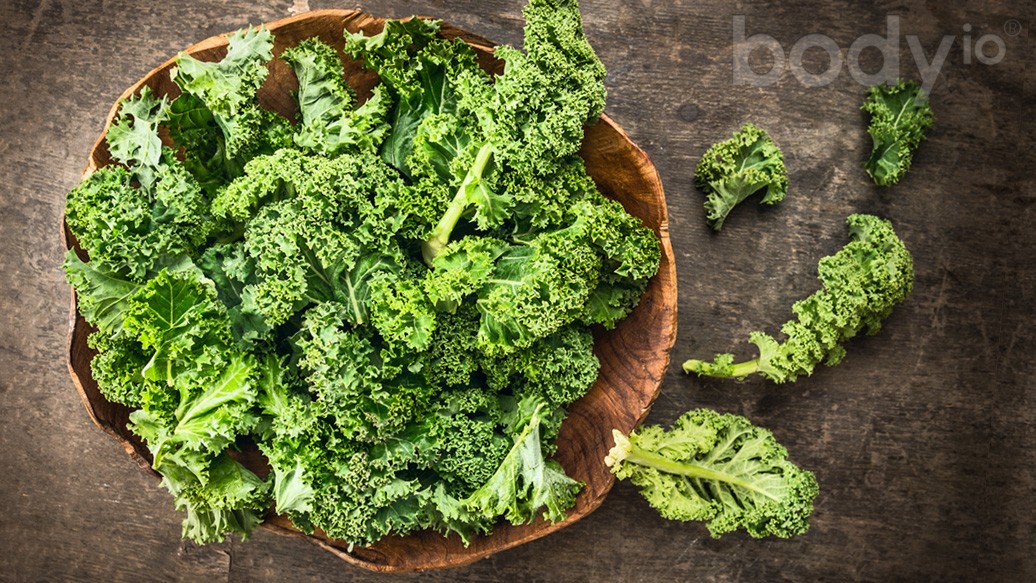elaying unbiased science in a field littered with so many unscientific voices opens the door for ridicule, and often of the ad hominem nature. This is the side effect of being a physicist in the health and fitness industry. I don’t mind: when dealing with a subject so vital as health, fitness and longevity, it’s better to be right than popular. Actually, it’s a responsibility.
This brings us to our topic: is kale poisoning people, or can it?
The recent viral spread of kale-poisoning related articles typifies the breakdown of this process of unbiased, thoughtful, scientific writing. The article The Vegetable Detective started the controversy. The article wasn’t actually the problem. The many articles quoting large passages of the original, accompanied by a title designed to spread through the social media sphere were the problem. Different websites cherry-picked paragraphs and chose a shocking title—just like the title I chose—to generate the Holy Grail of the internet: eyeballs.
The blog from Mother Jones created the largest burst of interest because of its reputation as a respected investigative magazine. “Kale is a silent killer”, the sentiment of the article, triggered a flurry of copy-cat articles that tore through the internet. With the renewed fascination in juicing and the increased popularity of kale, I’m not surprised at the reaction.
Nor did the responses of Vox and The Huffington Post surprise me. The two countered with the idea that kale is just too healthy to eliminate from the diet and went so far to as to denigrate the subject of the original article, Ernie Hubbard, who suggested the link between obsessive kale ingestion and possible poisoning. Their snarky and derisive tone implied more than an accusation of shoddy science; Ernie, they suspect, is a shyster.
Ernie’s observations and conjecture are the sine quo non of science. Make observations and form an idea of the cause. These represent the first two critical components of the scientific method. Mother Jones author, Tom Philpott, made notice of this distinction and concluded that it’s worth looking into. Vox and the Huffington Post did not.
That the writers for Vox and the Huffington Post can’t identify the basic and quintessential components of science makes their arguments and motivations dubious, especially since they seemed to revel in the subtle personal attacks leveled at Ernie Hubbard.
What’s the Problem with Kale?
The interesting fact about kale and other members of the Brassica family (including broccoli, green cabbage, collards, brussel sprouts and rape seed) is that they appear accumulate the heavy metal thallium from the soil[1-3], which is poisonous.
Thallium mimics potassium in the body and can therefore disrupt vital regulatory processes at the cellular level[4]. It was once used as a rat and ant poison and has a rather dark history as a human poison as well. Aside from this acute and quick response that can lead to a painful death, thallium may also interfere with the chemistry of certain amino acids, making prolonged, low-grade exposure carcinogenic[5].
What caused the uproar about kale in particular among the Brassica members is that it can hyper accumulate thallium to levels above what might be expected for the amount found in the soil[1, 2]. Even minor amounts of contamination in the soil may cause relatively high amounts in the leaves of kale, particularly baby kale.
Researchers noted when examining thallium levels in different vegetables from different levels of contamination that match levels found in growing regions, that “uptake of thallium from soils with naturally high content of thallium can be high enough to seriously endanger food chains.”[1]
If we’re growing kale or other Brassica species in areas where thallium contamination exists, then concern is warranted.
The Perfect Kale-storm
Kale has been growing in popularity for a few years now, with the harvest of kale doubling between 2007 and 2012[6]. I’m sure this won’t last long. Remember when endive was all the rage? You probably don’t. That’s my point.
The major three producers of kale in the United States are California, Georgia and New Jersey[6]. To explore the thallium risk from kale, we need to know if any of these areas have higher than normal levels of thallium contamination.
Many states in the Midwest and South use a fertilizer derived from the burning of coal known as fly ash, which does contain thallium[7, 8] which can leach into the soil[9]. New Jersey’s soil contains higher than normal levels of thallium dating as far back as 1989[10]. And California, although it doesn’t use fly ash, is now becoming contaminated from natural levels of thallium in the ground water that have reached alarming concentrations because of epic drought conditions[11].
Wherever kale grows, it’s probably growing in soil contaminated with thallium. That’s a problem.
If the US government weren’t trying to find creative ways to dispose of fly ash to decrease power plant waste, or if California weren’t suffering the worst drought in 1200 years, or if the popularity of kale had spiked a decade earlier, worrying about thallium levels from kale would probably be moot. But everything seems to be conspiring to provide a reason to worry.
With Cause for Concern, Why All the Controversy?
Authors at Vox and The Huffington Post came to similar conclusions as one another: kale is just so healthy, you should eat as much as you want until someone proves that it might be poisonous. The last group to unabashedly defend the position that although it might be dangerous, you should continue unlimited usage until we know for certain that it’s dangerous was the tobacco industry.
Both articles exposed a bias to follow government guidelines as the path to health. This bias influenced their rebuttals to the kale hypothesis, each of which read more like diatribes in defense of the USDA Food Plate rather than well constructed, well researched and well executed arguments.
I’m skeptical of the ubiquitous idea that eating anything that grows directly out of the ground must be healthy. Most of the vegetables that experts recommend were considered weeds less than 500 years ago. The vast panoply of vegetables today constitutes a very recent addition to the human diet. They’re also filled with potent and toxic chemicals that the plants produce as a defense mechanism.
In reality, we have no compelling evidence that copious vegetable consumption equals greater health. Populations of modern living vegetarians and vegans with the highest levels of vegetable consumption still develop cancer as often as their weight and age controlled meat-eating peers who fail to get their daily vegetable quota[12-17]. There’s also no difference in longevity or heart disease[18].
Historically, this obsession with vegetable consumption is relatively new, and is a product of government policy rather than scientific inquiry. The historical events leading to this are beyond the scope of this article, but 100 years ago, a diet too high in vegetables and too low in animal products was seen as a health risk, a time when you could only witness extreme obesity at the circus and cancer was still rare and mysterious.
Epidemiological studies do suggest that people who eat more vegetables tend to possess greater levels of health. But epidemiology is observation, the first step in the scientific method. We need to run experiments to determine if vegetables confer some special health promoting properties—which we’ve never done—because many more compelling reasons exist, most of which have nothing to do with the actual consumption of vegetables.
The authors defending kale lambaste Ernie Hubbard for shoddy science because he bases suggestions on observation and not published studies; it’s a case of the pot calling the kettle black.
The controversy, in this case, as in many other health related discussions, stems from unfounded bias.
The Real Issue
Thallium poisoning from the over consumption of kale isn’t the problem here, but rather a manifestation of a bigger issue.
The viral-kale episode should have opened up a discussion and a concern for the agricultural practices in the United States and the oft ignored implications of drought and other weather conditions on our food supply. Kale is not to blame for the possible toxicity; poor environmental conditions and questionable farming practices are. The thallium exposure from kale is a symptom. If we take the issue seriously, we can make better decisions about what food we buy and which vegetables we choose to eat.
Thallium contamination also doesn’t start and stop with kale; kale just happens to be uniquely adept at accumulating thallium. The only thing that researchers found to be better—or worse from a contamination perspective—was kohlrabi. But several common food items also accumulate thallium to some degree: celery, broccoli, cabbage, brussel sprouts and rape seed, from which we extract canola oil and use as cattle feed, and even zucchini[19].
Final Thoughts
The conversation about kale and thallium toxicity underlies a much broader context. We shouldn’t really be arguing over the merits of kale versus its toxicity. The real conversation is this: abnormal weather patterns and our agricultural practices introduce contaminates that might be showing up in our food supply at levels higher than expected—dangerous levels.
We can’t ignore these issues. Who cares about the kale? I don’t even like kale and ingesting copious amounts won’t wash away the country’s health issues. I do, however, want to know what’s in the soil my vegetables come from—all of them, especially since I do like broccoli and Brussels sprouts which also accumulate thallium.
The kale-debacle represents the sad state of health and nutrition reporting. The popularist obsession with buying organic and eating as many vegetables in a day as possible isn’t the right recommendation. Because of this rampant push toward organic, the government approved tons of cheap fly ash as fertilizer. The demand requires a solution that’s cheap and scalable, something which traditional organic farming is not. But fly ash is cheap and with a little political positioning, despite the arsenic, uranium and thallium, fly ash is allowed and encouraged in organic farming[20, 21] despite a lack of safety data[22].
If you’re worried about your food and the environment, you should buy local, not organic. The two are not equivalent. I go out of my way to avoid buying anything labeled organic unless I can ask the farmer how they grow their produce. And if I’m asking the farmer, then it’s local. My position may not be the popular one, but it is, right now, the responsible one.
In a real sense, kale did enter into the US health conversation as a silent killer—a killer of responsible journalism.
What Can You Do?
We now find ourselves staring at a real risk. A few simple solutions exist, or at least, counter measures.
1. Limit consumption of kale.
There’s really no need to consume massive amounts when so many leafy green alternatives exist. You also probably shouldn’t eat copious amounts of kohlrabi either.
2. Don’t buy organic.
As I explained in my article about organics, the hybrid plants used produce more toxins and, in the case of kale, it’s likely they accumulate more thallium in the leaves as a defensive mechanism against being eaten by pests. You also need to worry about any vegetables grown in the US that bear the organic label. Fly ash—which is contaminated with various heavy metals, not just thallium—is, by definition an organic fertilizer and is used on commercial organic farms.
3. Consider not using powdered green mixes.
This whole issue raises concerns about the highly concentrated powdered green mixes, especially those certified organic. If they contain high concentrations of the good stuff in veggies, they might contain high concentrations of the bad stuff. I’d like to see an analysis of uranium, arsenic and thallium levels in these products; better to be safe than sorry.
4. Skip the kale smoothie for your kids.
If there is any risk, the ones to suffer the worst and most long lasting effects would be children because of their high rate of cellular turnover. If thallium does interfere with amino acid metabolism, the long term consequences would be significant and manifest themselves later in life as mysterious chronic ailments. Like I said, the plethora of vegetable options gives you plenty of kale alternatives, and plenty of variety.
Note that I didn’t suggest avoiding kale at all costs. I don’t and I won’t. If it shows up accompanying short ribs, I’ll eat it as part of the dish. I’m not that worried. But I’d think twice before guzzling multiple kale smoothies as part of a daily ritual (because of the thallium, not because it’s ridiculous…which it is).
[expand title=”References (click to expand)”]
- Pavlícková J, Zbíral J, Smatanová M, Habarta P, Houserová P, Kubán V. Uptake of thallium from naturally-contaminated soils into vegetables.Food Addit Contam. 2006 May;23(5):484-91.
(https://hal.archives-ouvertes.fr/hal-00577579/document) - Pavlícková J, Zbíral J, Smatanová M, Habarta P, Houserová P, Kubán V. Uptake of thallium from artificially contaminated soils by kale (Brassica oleracea L. var. acephala). Plant Soil Environ. 2006 Dec;52(12):544-49.
(https://www.researchgate.net/profile/Vlastimil_Kuba/publication/242699496_Uptake_of_thallium_from_artificially_contaminated_soils_by_kale_(Brassica_oleracea_L._var._acephala)/links/0046352eb81086c6a7000000.pdf) - Pavlícková J, Zbíral J, Smatanová M, Houserová P, Cizmárová E, Havlíková S, Kubán V. Uptake of thallium from artificially and naturally contaminated soils into rape (Brassica napus L.). J Agric Food Chem. 2005 Apr 20;53(8):2867-71.
(https://www.ncbi.nlm.nih.gov/pubmed/15826032) - Mulkey JP, Oehme FW. A review of thallium toxicity. Vet Hum Toxicol. 1993 Oct;35(5):445-53. Review.
(https://www.ncbi.nlm.nih.gov/pubmed/8249271) - Rodríguez-Mercado JJ, Altamirano-Lozano MA. Genetic toxicology of thallium: a review. Drug Chem Toxicol. 2013 Jul;36(3):369-83. Review.
(https://www.ncbi.nlm.nih.gov/pubmed/22970858) - Martin A. Boom Times for Farmers in the United States of Kale. Bloomberg.com 2014 May.
(https://www.bloomberg.com/bw/articles/2014-05-09/farmers-are-growing-a-lot-more-kale-now-ag-census-reports) - Sager M. Determination of arsenic, cadmium, mercury, stibium, thallium and zinc in coal and coal fly-ash. Fuel. 1993 Sep;72(9):1327-30.
(https://www.sciencedirect.com/science/article/pii/001623619390132L) - Christensen JK, Kryger L, Pind N. The determination of traces of cadmium, lead and thallium in fly ash by potentiometric stripping analysis. Anal Chim Acta. 1982 Sep;141(1):131-46.
(https://www.sciencedirect.com/science/article/pii/S0003267001953176) - Testoff A. Estimating the Potential Release of Thallium from Fly Ash Under Different Environmental Scenarios. Ohio State University Research Thesis. 2013.
(https://kb.osu.edu/dspace/bitstream/handle/1811/54413/AlexTestoffthesis.pdf?sequence=1) - CDC Report. (https://www.atsdr.cdc.gov/toxprofiles/tp54-c5.pdf)
- Belitz K, Fram MS, Johnson TD. Metrics for Assessing the Quality of Groundwater Used for Public Supply, CA, USA: Equivalent-Population and Area. Environ Sci Tech. 2015;49(14):8330-8338.
(https://pubs.acs.org/doi/full/10.1021/acs.est.5b00265) - Key TJ, Appleby PN, Spencer EA, Travis RC, Roddam AW, Allen NE. Mortality in British vegetarians: results from the European Prospective Investigation into Cancer and Nutrition (EPIC-Oxford). Am J Clin Nutr. 2009 May;89(5):1613S-1619S.
(https://ajcn.nutrition.org/content/89/5/1613S.long) - Appleby PN, Key TJ, Thorogood M, Burr ML, Mann J. Mortality in British vegetarians. Public Health Nutr. 2002 Feb;5(1):29-36.
(https://www.ncbi.nlm.nih.gov/pubmed/12001975) - Key TJ, Fraser GE, Thorogood M, Appleby PN, Beral V, Reeves G, Burr ML, Chang-Claude J, Frentzel-Beyme R, Kuzma JW, Mann J, McPherson K. Mortality in vegetarians and non-vegetarians: a collaborative analysis of 8300 deaths among 76,000 men and women in five prospective studies. Public Health Nutr. 1998 Mar;1(1):33-41.
(https://www.ncbi.nlm.nih.gov/pubmed/10555529) - Key TJ, Fraser GE, Thorogood M, Appleby PN, Beral V, Reeves G, Burr ML, Chang-Claude J, Frentzel-Beyme R, Kuzma JW, Mann J, McPherson K. Mortality in vegetarians and nonvegetarians: detailed findings from a collaborative analysis of 5 prospective studies. Am J Clin Nutr. 1999 Sep;70(3 Suppl):516S-524S.
(https://ajcn.nutrition.org/content/70/3/516s.long) - Thorogood M, Mann J, Appleby P, McPherson K. Risk of death from cancer and ischaemic heart disease in meat and non-meat eaters. 1994 Jun 25;308(6945):1667-70.
(https://www.ncbi.nlm.nih.gov/pmc/articles/PMC2540657/) - Kinlen LJ, Hermon C, Smith PG. A proportionate study of cancer mortality among members of a vegetarian society. Br J Cancer. 1983 Sep;48(3):355-61.
(https://www.ncbi.nlm.nih.gov/pmc/articles/PMC2011469/) - Kwok CS, Umar S, Myint PK, Mamas MA, Loke YK. Vegetarian diet, Seventh Day Adventists and risk of cardiovascular mortality: a systematic review and meta-analysis. Int J Cardiol. 2014 Oct 20;176(3):680-6. Review.
(https://www.internationaljournalofcardiology.com/article/S0167-5273(14)01290-X/abstract) - Brake SS, Jensen RR, Mattox JM. Effects of coal fly ash amended soils on trace element uptake in plants. Environ Geol. 2004 Mar;45(5);680-9.
(https://link.springer.com/article/10.1007/s00254-003-0921-z) - USDA National Organic Program, 2015.
(https://www.ecfr.gov/cgi-bin/text-idx?c=ecfr&sid=3f34f4c22f9aa8e6d9864cc2683cea02&tpl=/ecfrbrowse/Title07/7cfr205_main_02.tpl) - Clark RB, Ritchey KD, Baligar VC. Benefits and constraints for use of FGD products on agricultural land. Fuel. 2001;80(6):821-828.
(https://naldc.nal.usda.gov/download/3312/PDF) - Basu M, Pande M, Bhadoria PBS, Mahapatra SC. Potential fly-ash utilization in agriculture: a global review. Prog Nat Sci. 2009;19(10):1173-1186.
(https://www.sciencedirect.com/science/article/pii/S1002007109001579)
[/expand]














